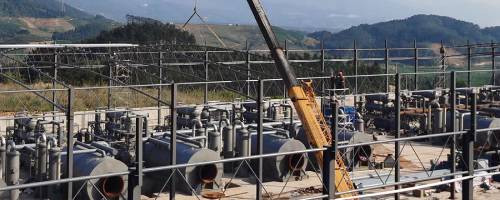Continuous pyrolysis of plastic and waste tires
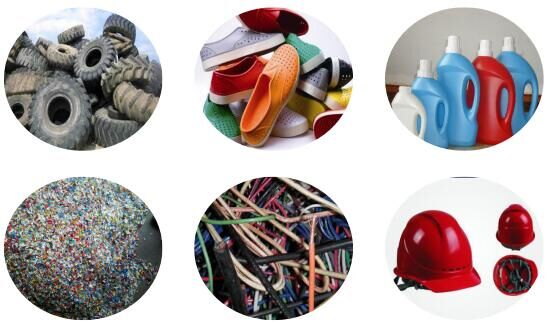
Waste tire/plastic
Plastics are user friendly but not eco-friendly as they are non-biodegradable. Generally it is disposed by way of land filling or incineration of materials which are hazardous. The better binding property of plastics in its molten state has helped in finding out a method of safe disposal of waste plastics, by using them in road laying.
Only in the EU, USA and Japan around 6 million tones per year of scrap tires are produced. The huge quantity of waste tires presently produced in the world will certainly increase in the future as the associated automotive industries grow. The dispos al of scrap tires becomes a serious environmental problem. The accumulation of discarded waste tires leads to environmental pollution. A large fraction of the scrap tires is simply dumped in sites where they represent hazards such as diseases and accidental fires. Rubbers are not biologically degr adable, and this fact creates problems with their disposal. The impact of waste rubber on the environment can be minimized by recycling with material or energy recovery. However, during processing and moulding rubber materials are crosslinked, and therefore they cannot be simply again softened and remoulded by heating. For many years landfill, was the main, practical mean s for dealing with the problem of waste tires. However, landfilling of tires is declining as a disposal option, since tires do not degrade easily in landfills, they are bulky, taking up valuable landf ill space and preventing waste compaction.
Only in the EU, USA and Japan around 6 million tones per year of scrap tires are produced. The huge quantity of waste tires presently produced in the world will certainly increase in the future as the associated automotive industries grow. The dispos al of scrap tires becomes a serious environmental problem. The accumulation of discarded waste tires leads to environmental pollution. A large fraction of the scrap tires is simply dumped in sites where they represent hazards such as diseases and accidental fires. Rubbers are not biologically degr adable, and this fact creates problems with their disposal. The impact of waste rubber on the environment can be minimized by recycling with material or energy recovery. However, during processing and moulding rubber materials are crosslinked, and therefore they cannot be simply again softened and remoulded by heating. For many years landfill, was the main, practical mean s for dealing with the problem of waste tires. However, landfilling of tires is declining as a disposal option, since tires do not degrade easily in landfills, they are bulky, taking up valuable landf ill space and preventing waste compaction.
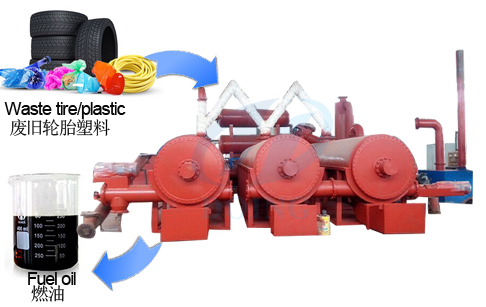
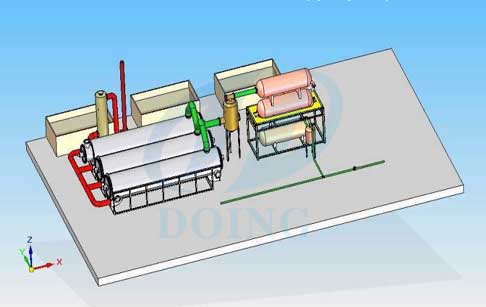
Continuous pyrolysis of plastic and waste tires 3D picture
HennanDoing company produced the continuous pyrolysis of plastic and waste tires ,the pyrolysis plant can convert waste plastic into fuel oil ,carbon black .the fuel oil can apllicatin glass factory,cement factory ,brick factory,etc.
Technical data of continuous pyrolysis of plastic and waste tires
| No. | Item | Specifications | ||||||
| 1 | Model | DY-C-10 | DY-C-20 | DY-C-30 | DY-C-50 | DY-C-60 | DY-C-80 | DY-C-100 |
| 2 | Cpacity | 10T/D | 20T/D | 30T/D | 50T/D | 60T/D | 80T/D | 100T/D |
| 3 | Power | 35Kw | 50Kw | 65Kw | 80Kw | 90Kw | 105Kw | 120Kw |
| 4 | Working type | Continuous | ||||||
| 5 | Reactor deisgn | Mutiple reactors (The quantity and size depends on the raw material condition) | ||||||
| 6 | Rotating | Internal rotating | ||||||
| 7 | Cooling system | Recycled waster cooling | ||||||
| 8 | Reactor material | Q245R/Q345R boiler plate | ||||||
| 9 | Heating method | Indireact hot air heating | ||||||
| 10 | Heating fuel | Fuel oil/gas | ||||||
| 11 | Feedstock | Waste tire/plastic/rubber | ||||||
| 12 | Output | Fuel oil, carbon black | ||||||
Final product of continuous pyrolysis of plastic and waste tires
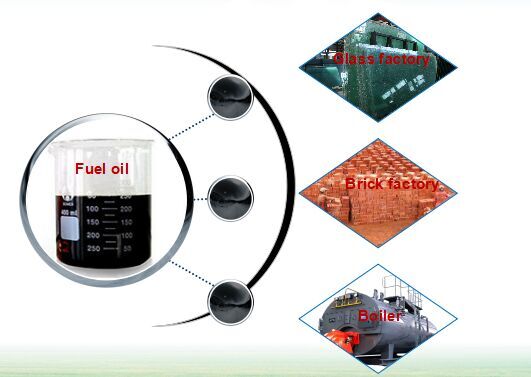
Fuel oil application
Request Information
Send your inquiry for further information




